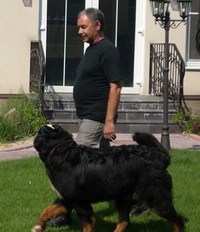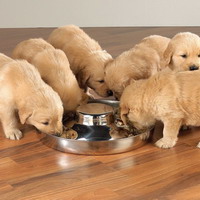Team Near
 A young dog pulling on a leash is a familiar picture. This suggests that the owner missed the time when it was necessary to use a jerk chain. Many owners are very fond of strict collar – parfors. They put this metal “thorn” on the neck of a six-month-old puppy and believe that he will independently learn to walk near his left leg. However, this is not the case. The “Nearby!” Team needs to be worked out for a long time and carefully. You will never teach a dog to walk alongside if you neglect the “boring and tedious” daily repetition of special exercises.
A young dog pulling on a leash is a familiar picture. This suggests that the owner missed the time when it was necessary to use a jerk chain. Many owners are very fond of strict collar – parfors. They put this metal “thorn” on the neck of a six-month-old puppy and believe that he will independently learn to walk near his left leg. However, this is not the case. The “Nearby!” Team needs to be worked out for a long time and carefully. You will never teach a dog to walk alongside if you neglect the “boring and tedious” daily repetition of special exercises.
I do not recommend using Parfors for permanent wear. To practice the “Near!” Command with a half-year-old dog, it is enough to use a metal jerk chain, the name of which itself indicates the possibility of reminding the animal by a short sharp jerk that it behaves incorrectly. Do not use such now popular nickel-plated chains as a leash, as they are inconvenient and even painful to squeeze and fix in your hand while the dog is jerking. In addition, there is a danger of injury if your finger is stuck in a chain link at the time of the jerk. Use a durable canvas leash with a length of 3-4 meters, and pay attention to the fact that both ends – junction points for the arm and the ring for the carabiner – were not simply joined by rivets, but stitched with threads to increase the strength. Be sure to pick up the carbine in accordance with the size of your dog. Remember, the whole dog “ammunition” should be extremely reliable!
In addition, learn how to properly hold a long leash. When practicing the command “Near!” The dog is on the left of the trainer. Your left hand grabs the leash about 60–70 cm from the carbine (the point of connection with the collar) so that the leash is sagging. The rest of the leash is taken in the right hand. The left hand grabs the leash so that the back of the hand is at the top. In other words, the leash enters the relaxed fist from the side of the little finger, but comes out from the side of the thumb of the left hand, while the thumb is under the leash. The muscles of the forearm and shoulder should be relaxed, the arm is lowered along the body – this is the initial state.
Strong leap jerk produced as follows. The arm is bent at a right angle at the elbow joint, and then abruptly, in an arc, thrown down and back, behind the back. You can make and “short” jerks, working with one relaxed brush. Muscles at the same time are relaxed and tense only at the time of tension of the leash. The jerk at the same time turns out not pulling, but sharp – directing. Immediately after the jerk, the arm is returned to its original position, i.e., lowered along the body.
You should also learn how to perform a series of light “small” jerks – at least 5-6 jerks in a row. Such continuous action by the leash forms in the dog an active desire to avoid them. Dodging the leash jerks, the dog itself takes the right position near the left leg. Sometimes even sharp and strong, but single jerks are less effective than such an impact. To enhance the impact, you can use your own body weight, in this case, a hand jerk must be combined with a step back or to the side, depending on the direction of the reaction. In order to protect the skin of the palms from unpleasant sensations during sharp jerks of the dog, you can wear leather gloves.
Initially, start your classes in a quiet place where no one will disturb you. Pat yourself on the left leg and start moving with it, at the same time commanding: “Dick, next!”. Some trainers recommend marking the first step with the “Forward!” Or “Go!” Commands. Whatever the case, remember that the dog must receive a signal from you, signifying the beginning of the movement.
When practicing walking skills near the trainer, be sure to remember the most important rule: the leash should not be taut all the time, like a string. An attempt by a dog to pull a leash in any direction should be instantly stopped by a short jerk, which your pet will try to avoid. When the dog goes calmly and stays next to you, the chain around his neck loosens, the leash sags freely, and the unpleasant choking sensations are stopped. If the dog tries to lag behind, pulls forward or to the side, threateningly say “Near!”, And after 2 seconds, shortly and sharply pull the leash. Pull and immediately release.
Give the dog a mistake! “Magic” 2 seconds is the time between the conditioned (“Next!” Command) and the unconditioned (leap jerk) stimulus necessary to form the arc of the conditioned reflex. If the dog pulls over and over again, be persistent, repeating the procedure the necessary number of times. It is important not to pull the leash, namely pull short and sharp, and your impact should be strong enough to produce an effect.
Try different exposure options, producing different amplitudes and serial jerks (see above). Naturally, the jerking vector should be opposite to the direction of movement of the dog. Ideally, when your dog obediently goes on the command “Near!”


